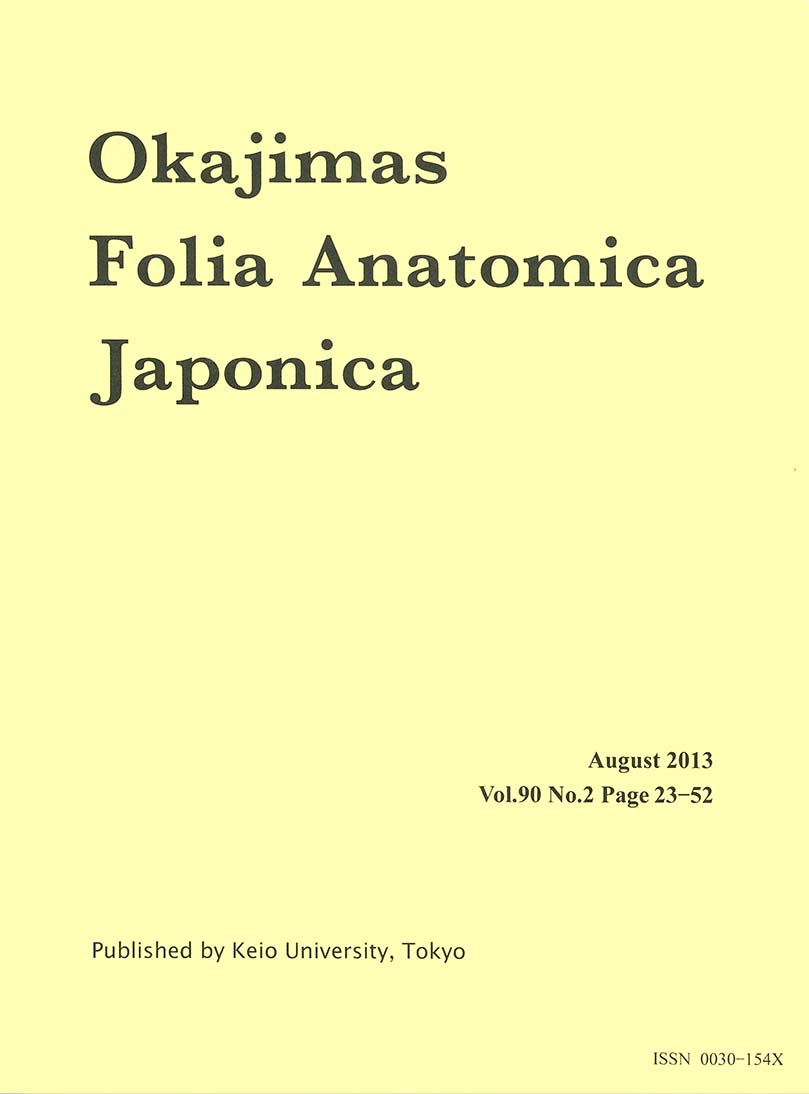All issues

Volume 90 (2013)
- Issue 4 Pages 79-
- Issue 3 Pages 53-
- Issue 2 Pages 23-
- Issue 1 Pages 1-
Predecessor
Volume 90, Issue 2
Displaying 1-3 of 3 articles from this issue
- |<
- <
- 1
- >
- >|
CONTENTS
-
Fumihiko SUWA, Mamoru UEMURA, Akimichi TAKEMURA, Isumi TODA, Yi-Ru FAN ...2013Volume 90Issue 2 Pages 23-29
Published: 2013
Released on J-STAGE: October 10, 2013
JOURNAL FREE ACCESSThe injection of acrylic resin into vessels is an excellent method for macroscopically and microscopically observing their three-dimensional features. Conventional methods can be enhanced by removal of the polymerization inhibitor (hydroquinone) without requiring distillation, a consistent viscosity of polymerized resin, and a constant injection pressure and speed. As microvascular corrosion cast specimens are influenced by viscosity, pressure, and speed changes, injection into different specimens yields varying results. We devised a method to reduce those problems. Sodium hydroxide was used to remove hydroquinone from commercial methylmethacrylate. The solid polymer and the liquid monomer were mixed using a 1 : 9 ratio (low-viscosity acrylic resin, 9.07 ± 0.52 mPa•s) or a 3:7 ratio (high-viscosity resin, 1036.33 ± 144.02 mPa•s). To polymerize the acrylic resin for injection, a polymerization promoter (1.0% benzoyl peroxide) was mixed with a polymerization initiator (0.5%, N, N-dimethylaniline). The acrylic resins were injected using a precise syringe pump, with a 5-mL/min injection speed and 11.17 ± 1.60 mPa injection pressure (low-viscosity resin) and a 1-mL/min injection speed and 58.50 ± 5.75 mPa injection pressure (high-viscosity resin). Using the aforementioned conditions, scanning electron microscopy indicated that sufficient resin could be injected into the capillaries of the microvascular corrosion cast specimens.View full abstractDownload PDF (2521K) -
Hideki OHNO, Shunsuke GOTO, Masao OWAKI, Joji OHTA, Naoshi NAKAJIMA, K ...2013Volume 90Issue 2 Pages 31-39
Published: 2013
Released on J-STAGE: October 10, 2013
JOURNAL FREE ACCESSAndrogen is closely involved as the cause of rupture of anterior cruciate ligament (ACL) in human. In dogs, however, factors contributing to rupture of ACL remain unknown. In this study, expression of androgen receptor (AR) and histological distribution of blood vessels in ACL, and serum testosterone concentration were investigated in relation with age and sex to confirm whether canine ACL is an androgen-responsive tissue. Materials of ACL were obtained from 26 dogs: 12 young female Beagles, 2 old female mixed breeds, 9 young male Beagles, and 3 old male mixed breeds. In all canine ACL, positive AR expression was recognized in the nuclei of the fibrocytes, fibroblasts, synovial cells, and vascular endothelial cells of ACL. Expressions of AR were lesser in old males compared to the young males; however, females had no age difference in expression. Distributions of blood vessels in the synovial membrane of the ligament were fewer in old dogs both of males and females than youngs. Although distributions of vessels in the interstitium were apparently fewer in young females. Serum testosterone concentration was significantly higher in young males. Females had no age difference in the levels. From these results, it is suggested that canine ACL is an androgen-responsive tissue, and this consideration seems to closely relate to the epidemiological background that the incidence of rupture of ACL of dogs is higher in females than in males.View full abstractDownload PDF (4641K) -
Moritoshi UCHIDA, Rie IKEDA, Kenichiro KIKUCHI2013Volume 90Issue 2 Pages 41-52
Published: 2013
Released on J-STAGE: October 10, 2013
JOURNAL FREE ACCESSHormones have been reported to be involved in salivary gland’s growth and development, but few studies have investigated the effects of glucocorticoids on the morphology of the sublingual glands around the weaning period. The objective of this study was to ascertain the effects of glucocorticoid administration on rat sublingual glands around the weaning period. Male Wistar rats were administered triamcinolone, a glucocorticoid, once every other day from 8 days after birth (experimental group). A control group was given vehicle only. The sublingual glands were then extracted at 15, 20, 25, and 30 days after birth. Samples thus obtained were subjected to Alcian blue and periodic acid-Schiff staining, lectin staining, and immunohistochemical staining to assess cellular proliferative potential. And acinar cell circumferences were measured. We found that glucocorticoid had no effect on the production of acid or neutral mucopolysaccharides by acinar cells around the weaning period. Glucocorticoid administration resulted in hypertrophy of acinar cells between 15 and 30 days after birth. Early appearance of changes in α-mannose, α-glucosamine, and N-acetylglucosamine in secretory granules suggested that glucocorticoid may have acted to promote cell differentiation. The glucocorticoid had no effect on the proliferative potential of sublingual gland acinar cells around the weaning period.View full abstractDownload PDF (12669K)
- |<
- <
- 1
- >
- >|